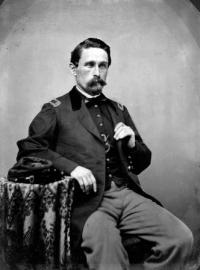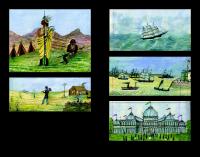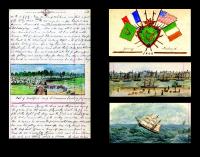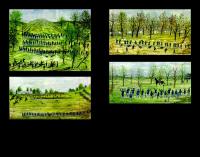The luck of Andrew J. Byrne
Published in
18th–19th - Century History,
Features,
Issue 6 (Nov/Dec 2010),
Volume 18

Lt Andrew J. Byrne (1830–1911), 65th New York State Volunteers (August 1861–February 1864).
One night in summer 1865, Andrew Byrne returned to his hotel room in New York a little the worse for wear after a night of drinking with friends. Drowsy with wine, he blew out the light without turning off the gas, which filled the room as he slept heavily. Fortuitously, a fanlight over his door was open, so that he woke up in the morning and realised his lucky escape. Andrew Byrne was quite a lucky man all his life. He endured much travail, including an unhappy first marriage. His career was an adventurous one, at least until his last return to Ireland in 1875 at the age of 45. As well as witnessing the American Civil War, he served in the peacetime US army on the 1850s frontier, though he avoided the Indian wars. He had a minor role in the Fenian Rising, and was deported for his part in the conspiracy. His photograph shows a handsome man with soft, doe-like eyes, large moustache and a determined set to his jaw. We are fortunate to have his memoirs, Memoir of Andrew J. Byrne, veteran of the American Civil War, published in 2008 by his grandson, Seamus Condon. The original, with 325 pages, six poems and 70 watercolours, was edited down to 213 pages, five poems and 65 watercolours in the published edition.
A common soldier
Andrew Byrne’s memoirs are of great interest, not just because of their content. There are not many lengthy accounts of men with his experiences. He was just one of an estimated 150,000 Irish-born soldiers who fought in the American Civil War on the Union side (c. 40,000 fought for the Confederacy). Apart from officers like Thomas Francis Meagher or Patrick R. Cleburne, we have few accounts of the ordinary Irish ‘grunts’ who struggled through the war. Byrne was in many ways a typical Civil War soldier. He recounts proudly the brave deeds of his regimental comrades, showing the group loyalty essential to maintain unit cohesion in battle. This is in spite of the fact that the Irish in the Northern states were lukewarm towards the war aims of Abraham Lincoln’s Republican government.

‘Comanche Indians’. Byrne first enlisted in the US army in New Orleans in 1849, and found himself serving in a remote Texan fort. Loneliness and the harshness of his surroundings caused him to desert and return to Ireland.
Andrew Byrne’s memoirs are of great interest, not just because of their content. There are not many lengthy accounts of men with his experiences. He was just one of an estimated 150,000 Irish-born soldiers who fought in the American Civil War on the Union side (c
. 40,000 fought for the Confederacy). Apart from officers like Thomas Francis Meagher or Patrick R. Cleburne, we have few accounts of the ordinary Irish ‘grunts’ who struggled through the war. Byrne was in many ways a typical Civil War soldier. He recounts proudly the brave deeds of his regimental comrades, showing the group loyalty essential to maintain unit cohesion in battle. This is in spite of the fact that the Irish in the Northern states were lukewarm towards the war aims of Abraham Lincoln’s Republican government.
It is a tribute to the high morale of the Union army that over half of the three-year volunteers who had enlisted early in the war re-enlisted before the conflict was over. We do not have exact figures for the re-enlistment rate of Irish soldiers, but they were probably as high. Andrew Byrne was one of those who loyally re-enlisted, though in his case ambition for promotion may have been an additional inducement.
Early life
Born in Dublin in 1830, Byrne came to adulthood against the backdrop of the Famine and the Young Ireland movement. He seems to have been on the fringes of Young Ireland politics, but does not mention any involvement in the 1848 disturbances. Later, one of the high points of his Civil War memoir is an encounter with Thomas Francis Meagher, whom he recalled from Dublin in the late 1840s.
In 1849 he was an apprentice in the building trade and purchased his emigrant ticket with his own earnings. He had often dreamed of going to America, but the immediate occasion seems to have been an impending family dispute. He had undertaken marriage unknown to his parents, who disapproved of his choice of partner. Landing in New Orleans with little money, he found it difficult to get employment, as most labouring jobs were filled by slaves. To get out of a jam, he enlisted in the US army, and found himself serving in a remote Texan fort. The pre-Civil War US army was mostly based on the frontier, and no doubt Byrne soon became bored by the loneliness and harshness of the surroundings. So he deserted, and fled back to Ireland and his wife. He was ‘taken aback’ to find her ‘somewhat cool and suspicious’! He made an honest attempt to settle down with his family. The couple had two children but their life together was unhappy. The marriage was marked by Byrne’s long absences, and he mentions his wife’s heavy drinking more than once.
In 1854 he enlisted in the Dublin Artillery Militia, which was called to duty when most British Army regiments were sent to the Crimea. He was still ‘. . . discontented and troubled for reasons I do not care to explain’. The adjutant of the regiment took the young man under his wing, however, and he actually gained promotion. After disbandment of the Militia in 1856, he used his bounty money to depart again for America, saying only that he ‘longed for freedom’. In New York he enlisted again in the US army under a false name. Byrne seems to have been drawn to a soldier’s life, and his actions from here on were those of a mature individual. He had a troubled conscience, and turned himself in to the army authorities for his Texas desertion. He was pardoned and allowed to serve out his earlier enlistment for two more years.
Into battle

Facsimile of a page from Byrne’s journal, including ‘Part of fortified camp at Harrison’s Landing, July, 1862’.
Byrne left the US army and returned to Ireland just as the Civil War broke out. Filled with a loyalty to the US government and ‘the flag under which I served’, he set out once more for New York. This time a daughter accompanied him. Possibly his wife was already in New York, or emigrated later. He enlisted in the 65th New York Volunteers, one of the many new regiments formed to suppress the secession of the Southern states. The fact that Byrne had over five years’ experience in two armies marked him out from the raw recruits. He was quickly promoted to sergeant and given the task of carrying the state colours of the regiment, making him a visible rallying point in battle.
At the time of the American Civil War, the standard infantry weapon was the rifled musket, a weapon demanding a complicated series of actions to load and fire. Soldiers needed to be drilled incessantly in order to consistently get off the standard three rounds per minute under combat conditions. Though Byrne had never experienced combat, his experience in drilling, his discipline and his steadiness were at a premium. Byrne makes an honest attempt to describe his feelings under fire. Though he does not succeed in recreating his battlefield experience satisfactorily, his account is of great merit. ‘All thoughts but that of death or the enemy flew out of my mind with the excitement and so busy firing.’ At that moment, his training took over.
Wounded at Malvern Hill
In the
unsuccessful 1862 campaign to capture Richmond, Byrne was wounded in a major battle, at Malvern Hill. These pages, describing his desperate plight at the most dangerous time of his life as a wounded prisoner-of-war, exert the most fascination of his entire memoir. He has a vivid recollection of being wounded (in the upper arm): ‘. . . as if I was stuck with a heavy instrument such as an axe or sledge with a lightning like stroke with great force’. Weak from loss of blood, he was left behind by the retreating army to become a prisoner-of-war. With other captives, he was lodged in Libby Prison at Richmond, Virginia, a converted cotton warehouse.
As a wounded prisoner, Byrne’s chances of survival were slim. There were no medical staff, food was scarce, hygiene was non-existent, his wound was sore, he became starved and weak, and his chronic discomfort was worsened by heat, dust and swarms of flies. With particular horror, he remembers a wounded man: ‘The flesh of his arms and face was red and scalded looking; the flies were actually eating him alive’. He does remember some kindnesses, such as that of the black teamster who brought him to the prison. His luck saved him, however. He was quickly handed over in a prisoner-of-war exchange and returned to hospital in the North. Byrne recalls with gratitude the nurses in charge of his care, adding ambiguously that ‘prayer meetings were held frequently, and were a source of amusement to a good many of the soldiers’.
Recovery and return

‘The surrender of Lee, 9th April, 1865’. Byrne was present near Appomattox courthouse on the occasion of Robert E. Lee’s surrender of the Confederate army in April 1865.
Byrne was lucky to survive, and also lucky not to lose his arm. He spent the rest of 1862 and most of 1863 recuperating from his wound, thereby missing some of the bloodiest battles of those years, like Antietam, Fredericksburg and Gettysburg. He returned to duty in time to take part in the 1864–5 Virginia campaign. In 1864 he suffered another wound, a flesh wound in the hip, which did not put him out of action for long. Byrne was present near Appomattox Court House on the occasion of Robert E. Lee’s surrender of the Confederate army (April 1865). Two months after the surrender, Byrne received news of his wife’s death in New York.
Later in the year, he crossed to Ireland bearing a message for James Stephens, the Fenian leader. In Ireland he became ill and was delayed in delivering his message. It seems that his commitment was only half-hearted. After being arrested, he was glad to be allowed to return to America, where he re-joined the army. He remarried and his second wife brought him the domestic contentment that his first marriage had not. After some further wandering, he returned with his family to Dublin in 1875 to gain modest prosperity at his original trade. Andrew J. Byrne died in 1911.
Byrne was a man of intelligence and some sensitivity, but his memoir is grammatically weak and his spelling wilfully wrong in places; nevertheless, the rough-hewn and plain style tells much about the man. He took pains with his writing. It is clear that he consulted the four-volume publication Battles and leaders of the Civil War (1887), a popular compendium of accounts by generals from both sides (still in use by historians today), in order to check his facts regarding the generals and divisions mentioned in his memoir.
His watercolour illustrations and five poems are diverting and lift his account above the ordinary. Though some are copies of magazine sketches done by professional artists, many are representations of his authentic memories, such as his drawings of life on the frontier. It is to his credit that he left such an invaluable memoir to his descendants, to his fellow Irishmen and to the country he risked so much to preserve. HI
Toby Joyce is an engineer with a strong interest in Ireland and the USA during the American Civil War.
Further reading:
S. Condon (ed.), The memoir of Andrew J. Byrne, veteran of the American Civil War, www.originalwriting.ie.
L.F. Kohl & M.C. Richard (eds), Irish Green and Union Blue: the Civil War letters of Peter Welsh (New York, 1986).
G.F. Linderman, Embattled courage: the experience of combat in the American Civil War (New York, 1989).
B.I. Wiley, The life of Billy Yank, the common soldier of the Union (Baton Rouge, 1978).




















